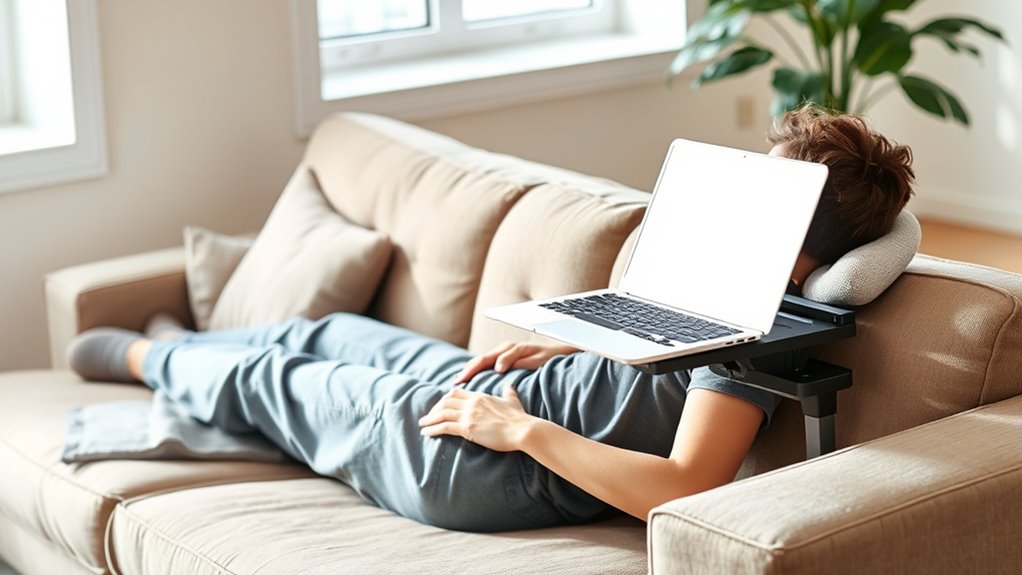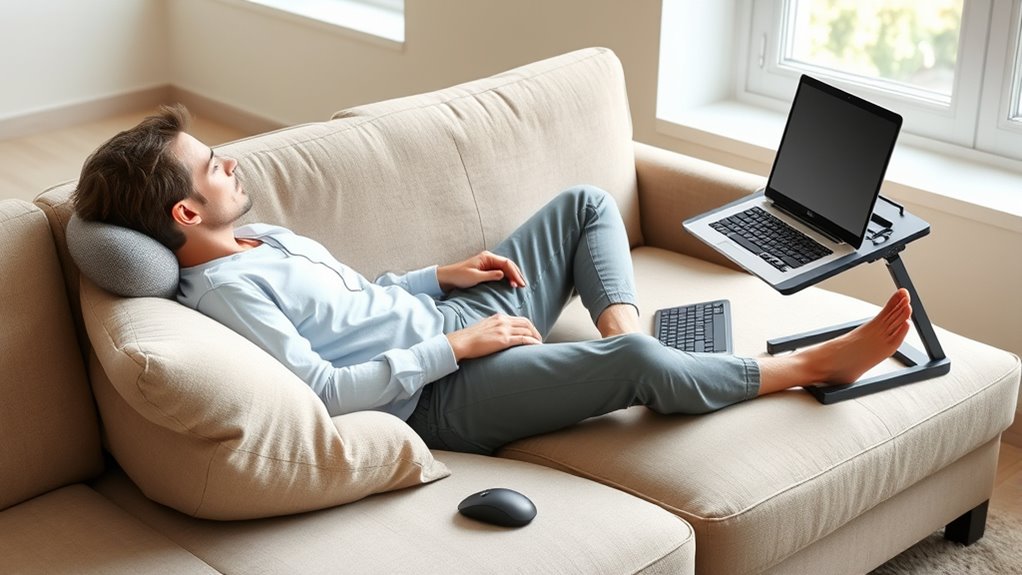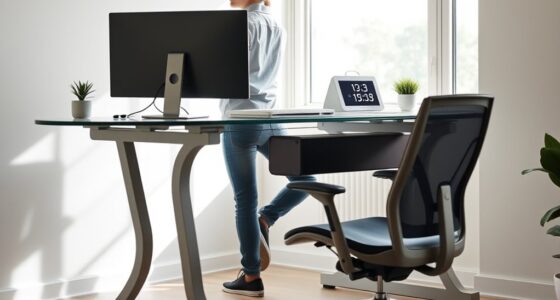To maintain good posture on the couch, choose a sturdy, supportive surface like a dedicated laptop stand or firm cushion, and position it at eye level. Sit with your back supported by a lumbar cushion, keep hips slightly higher than knees, and rest your forearms on cushions or armrests at a comfortable 90°. Take regular breaks to stretch and move, and consider using external devices like an adjustable stand or external keyboard. Keep these tips in mind for better comfort and explore more strategies below.
Key Takeaways
- Use a firm, stable surface like a tray or lap desk to support your laptop and prevent wobbling.
- Elevate your laptop screen to eye level with a stand or cushions to avoid neck strain.
- Sit upright with your back supported by lumbar cushions, and keep hips higher than knees for proper posture.
- Rest your forearms on cushions or armrests, maintaining elbows at 90° to reduce shoulder tension.
- Take regular breaks to stretch, shift positions, and promote circulation during prolonged use.
Choose the Right Supportive Surface

Choosing the right supportive surface is vital to maintaining good posture while using your laptop on the couch. Start with your cushion selection—pick one that offers enough padding to keep your laptop stable and comfortable. A firm, stable surface prevents your laptop from wobbling or slipping, which can cause strain. Surface stability is essential; a shaky or uneven surface forces you to adjust constantly, leading to poor posture and discomfort. Use a sturdy tray or a dedicated laptop stand designed for couch use to guarantee your device stays secure. Avoid placing your laptop directly on soft cushions or uneven surfaces, as they compromise stability. Prioritizing a supportive, stable surface helps maintain proper alignment, reducing fatigue and supporting your overall comfort during long use. Additionally, Surface stability is a key factor in reducing the risk of repetitive strain injuries and promoting ergonomic posture habits.
Adjust Your Seating Position and Laptop Height

To guarantee good posture while using your laptop on the couch, you need to adjust both your seating position and the height of your device. Start by placing a cushion behind your lower back for proper lumbar support, which encourages an upright sitting posture. Adjust your cushion placement to keep your hips slightly higher than your knees, promoting better alignment. Sit back so your back is fully supported and avoid slouching. Position your laptop so the screen is at eye level, reducing neck strain. Use arm support by resting your forearms on cushions or the armrests, keeping your elbows close to your sides at about a 90-degree angle. This setup minimizes shoulder tension and helps maintain a natural posture throughout your work session. Incorporating proper ergonomic adjustments can further enhance comfort and prevent strain during extended use.
Incorporate Movement and Stretching Breaks

Sitting in the same position for extended periods can lead to stiffness and discomfort, so it’s vital to incorporate movement and stretching breaks into your routine. Regularly shifting your posture helps prevent strain, and stretching routines keep your muscles flexible. Use ergonomic cushions to support your back and reduce pressure. Every 30 minutes, stand up and do simple stretches like shoulder rolls, neck tilts, or hamstring stretches to loosen tight muscles. Incorporate quick movements such as arm circles or torso twists to keep blood flowing. These small breaks alleviate tension, improve circulation, and enhance focus. Remember, posture awareness is essential—making conscious adjustments during your laptop sessions can significantly reduce discomfort. Make stretching routines and movement breaks a regular part of your laptop sessions to maintain comfort and good posture.
Use External Devices to Enhance Ergonomics

Using external devices can considerably improve your ergonomic setup and make long laptop sessions more comfortable. Ergonomic accessories, like adjustable stands or external keyboards, help position your laptop at eye level, reducing neck strain. An external mouse allows you to keep your wrist in a natural, relaxed position, preventing discomfort. Ergonomic cushions can support your lower back or hips, promoting proper spinal alignment while sitting on the couch. These accessories work together to create a more supportive environment, minimizing strain and fatigue. By investing in simple ergonomic tools, you can maintain better posture without sacrificing comfort. Remember, the goal is to keep your body aligned and relaxed, even during extended periods of laptop use. Recognizing body awareness can further help you adjust your posture and avoid discomfort over time.
Develop Healthy Habits for Long-Term Posture Maintenance

Establishing and sticking to healthy habits is essential for maintaining good posture over the long term. Developing consistent routines helps you stay mindful of your posture and prevents discomfort. Incorporate ergonomic accessories, like supportive cushions or adjustable laptop stands, to make maintaining proper alignment easier. Practice posture awareness by checking in with yourself regularly and correcting slouching or craning your neck. To build these habits, consider:
Build lasting good posture habits with routine, ergonomic support, and mindful self-checks.
- Setting reminders to adjust your posture throughout the day
- Using ergonomic accessories for better support
- Taking short breaks to stretch and reset
- Being mindful of your body’s signals and adjusting as needed
- Educating yourself about sustainable living principles to foster mindful choices that benefit both your health and the environment
Frequently Asked Questions
How Can I Prevent Neck Strain While Using My Laptop on the Couch?
To prevent neck strain while using your laptop, you should set up an ergonomic workspace. Use a supportive chair with lumbar support to keep your back straight, and elevate your laptop to eye level with a stand or cushion. This keeps your neck aligned and reduces tension. Take regular breaks to stretch, and avoid slouching, ensuring you stay comfortable and avoid long-term strain.
What Are the Best Cushions or Pillows for Ergonomic Support?
When choosing cushions or pillows for ergonomic support, focus on cushion materials like memory foam, which molds to your body, or supportive latex for durability. Opt for pillow shapes such as lumbar rolls or wedge-shaped cushions that promote proper posture. These options help maintain spinal alignment and reduce strain, making your couch work as a comfortable, supportive workspace. Proper support keeps you comfortable and prevents aches during long sitting sessions.
How Long Should I Take Breaks to Avoid Fatigue?
To avoid fatigue, you should take rest breaks every 30 to 60 minutes. This rest break frequency helps manage fatigue effectively, preventing strain and discomfort. During breaks, stretch, stand, or walk around to promote circulation. Listening to your body is key—if you feel tired sooner, take a break earlier. Regular breaks keep you focused, comfortable, and reduce the risk of musculoskeletal issues.
Can Specific Exercises Improve My Posture Over Time?
Yes, specific exercises can improve your posture over time. Incorporate posture correction exercises and stretching routines into your daily schedule to strengthen your back, neck, and shoulder muscles. These routines help reduce tension and promote proper alignment, making it easier to maintain good posture even during long periods of laptop use. Consistency is key, so dedicate a few minutes daily to these exercises for noticeable long-term improvements.
Are There Portable Ergonomic Tools Suitable for Couch Use?
Think of your workspace as a ship at sea—you need sturdy tools to stay balanced. Yes, portable stands and ergonomic mice act like steady anchors, making couch work safer and more comfortable. These tools are lightweight, easy to carry, and designed to help you keep good posture. With them, you can navigate your tasks smoothly, reducing strain and sailing confidently through your day’s work.
Conclusion
Staying comfortable and maintaining good posture on the couch is doable with the right setup and habits. Some might think it’s too complicated or uncomfortable, but with simple adjustments, you’ll find it’s easy to stay ergonomic. Remember, investing a few minutes now prevents long-term pain. So, don’t let concerns hold you back—your back will thank you for making these small changes today. Keep consistent, and good posture will become second nature.









